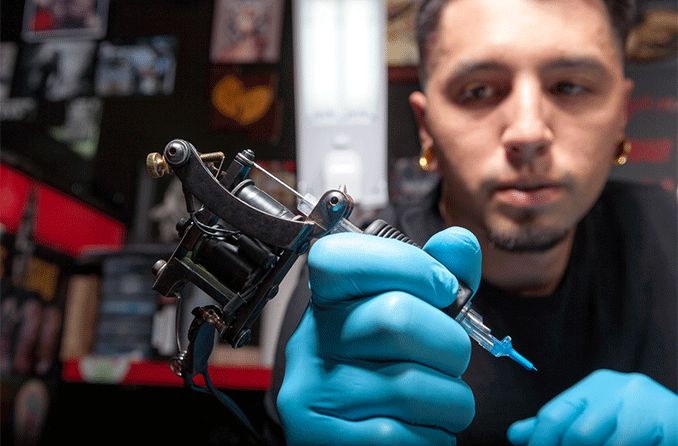Are eye tattoos as bad as they sound?

Eye tattoos are permanent dyes injected onto the white part of the eye, called the sclera. They also go by the name scleral tattoos.
If the idea of injecting ink into your eye makes you wince, it’s for good reason — an eyeball tattoo is one risky proposition.
Scleral tattoos are a relatively new addition to the body modification scene, considering humans have been tattooing their skin for thousands of years. The first known scleral tattoo was performed in 2007.
By contrast, the first corneal tattoo was likely done around 1,900 years ago by the famed Roman physician Galen of Pergamon. But Galen didn’t use his tattoo for artistic purposes; he used it to cover a white scar (leucomata) on an otherwise transparent cornea.
A laser-assisted version of Galen’s procedure can be performed today, but it’s only considered when people meet specific, rare conditions.
Scleral tattoos, on the other hand, aren’t used for any medical conditions. They’re almost exclusively “for looks,” and rarely — if ever — worth the risk.
How are eyeball tattoos even possible?

The white sclera is covered by a paper-thin membrane called the conjunctiva. That’s the layer that gets irritated and bloodshot when someone has pink eye or bad eye allergies.
Tattoo artists create scleral tattoos by injecting ink below the conjunctiva and onto the surface of the sclera.
It might sound simple, but eye tattoos haven’t been medically researched or tested, and several things can go wrong.
Risks involved with eye tattoos
A tattoo on your eye is very different from one you’d get on your skin. There are two main reasons for this:
Eye anatomy – The surface of the eye is extremely delicate and different from skin, which is thicker and less sensitive than eye tissue. Skin tattoos are generally a much safer option.
How they work – While traditional tattoos use tiny needles to carefully inject ink just below the upper layer of skin and “draw” it onto precise spots, scleral tattooing involves injecting the ink below a mucous membrane (conjunctiva) and allowing it to spread across the sclera below.
There isn’t any official training or certification process to perform eye tattoos, so problems can arise for many reasons. Tattoo artists might use the wrong ink or inject the ink too far into the sclera, for example.
In some cases, ink has actually gone through the surface of the eye and inside the eye itself. Serious problems can happen when ink gets inside your eye or spreads too far past the intended area.
Vision loss and blindness are among the most serious risks, but they’re far from the only ones.
Other risks associated with eyeball tattoos include:
Ongoing, often intense pain and inflammation.
Serious eye infections.
A permanent feeling that something is stuck in your eye.
Retinal detachment, which can also lead to vision loss or blindness.
Complete loss of the affected eye(s).
One woman’s eyes became so infected that she appeared to be “crying” purple ink and eventually lost part of her vision. Another man was in so much pain after a scleral tattoo that he needed to have his eye removed.
On top of these risks, eye tattooing makes it almost impossible for an eye doctor to examine the surface of your eye in the future.
Eye tattoos are so untested that some U.S. states have made it illegal to get one. At the time of publishing, lawmakers in the following states have passed bills outlawing scleral tattoos:
Oklahoma
Indiana
Utah
Nebraska
Washington
The Canadian provinces of Saskatchewan and Ontario, which include Toronto and Ottawa, have also banned eye tattoos.
If you’re considering an eye tattoo, take your time. Do a lot of research into the risks and how complications could affect your quality of life, should they occur. Speak with an eye doctor — preferably an ophthalmologist (medical eye doctor) — about any short- and long-term effects before you make your decision.
READ MORE: Costume contact lenses offer a safer alternative
More cosmetic eye health articles
Canthoplasty surgery for a larger, almond-shaped eye
Lash extensions: Pros, cons and helpful tips
Eyelid surgery: What it is, how much it costs, what the risks are
Eyebrow piercing: Complications and prevention
Tattoos. Smithsonian Magazine. January 2007.
Fresh ink. Review of Optometry. July 2014.
New surgical strategy for corneal tattooing using a femtosecond laser. Cornea. January 2009.
Corneal tattooing revisited: excimer laser in the treatment of unsightly leucomata. Australian and New Zealand Journal of Ophthalmology. August 1995.
Eyeball tattoos are even worse than they sound. American Academy of Ophthalmology. May 2019.
Tattoo you: Scleral tattoos pose threat to eye health. Ophthalmology Times. September 2020.
Model risks losing eye after tattooing it purple. USC Roski Eye Institute. January 2018.
Page published on Tuesday, April 6, 2021




